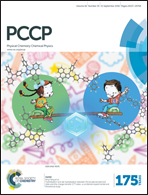Hydrogen evolution in [NiFe] hydrogenases and related biomimetic systems: similarities and differences†
Abstract
In this work, a detailed quantum chemical study of the mechanism of [Ni(bdt)(dppf)] (NiIIL) catalyzed hydrogen formation [A. Gan, T. L. Groy, P. Tarakeshwar, S. K. S. Mazinani, J. Shearer, V. Mujica and A. K. Jones, J. Am. Chem. Soc., 2015, 137, 1109–1115] following an electro-chemical-electro-chemical (ECEC) pathway is reported. The complex exclusively catalyzes the reduction of protons to molecular hydrogen. The calculations suggest that the first one-electron reduction of the [NiIIL] catalyst is the rate limiting step of the catalytic cycle and hence, the buildup of detectable reaction intermediates is not expected. The catalytic activity of the [NiIIL] complex is facilitated by the flexibility of the ligand system, which allows the ligand framework to adapt to changes in the Ni oxidation state over the course of the reaction. Additionally, a comparison is made with the catalytic activity of [NiFe] hydrogenase. It is argued that the directionality of the reversible hydrogen formation reaction is controlled by the ligand field of the nickel ion and the possibility for side-on (η2) binding of H2: if the ligand framework does not allow for η2 binding of H2, as is the case for [NiIIL], the catalyst irreversibly reduces protons. If the ligand field allows η2 binding of H2, the catalyst can in principle work reversibly. The conditions for η2 binding are discussed.
![Graphical abstract: Hydrogen evolution in [NiFe] hydrogenases and related biomimetic systems: similarities and differences](/en/Image/Get?imageInfo.ImageType=GA&imageInfo.ImageIdentifier.ManuscriptID=C6CP03672D&imageInfo.ImageIdentifier.Year=2016)

 Please wait while we load your content...
Please wait while we load your content...